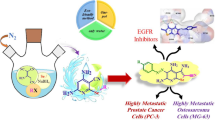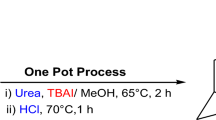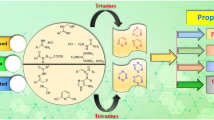Abstract
The reaction of the mutagenic 2-haloacroleins, 2-fluoroacrolein, 2-chloroacrolein and 2-bromoacrolein, with nucleosides and 5′-mononucleotides was studied. We found two different regioisomers of 1,N 2-cyclic deoxyguanosine adducts of 2-chloroacrolein and 2-bromoacrolein: type A, the 6-hydroxy, 7-haloadduct in which the OH-substituent is vicinal to the N 2-atom of the guanine moiety and type B, the 8-hydroxy, 7-haloadduct in which the OH-group is adjacent to the N1-atom of the guanine moiety. The major adducts were the trans pairs of diastereomers of type A and type B in which the 6,7-substituents as well as the 7,8-substituents are in the energetically favoured diaxial position of the newly formed tetrahydropyrimidine ring. In the case of the type A regioisomers, the cis pairs of diastereomers (traces with chloroacrolein and about 4% with bromoacrolein) were also found in which the halosubstituent probably takes the equatorial position. Due to the anomeric effect, the OH-group takes the axial position in both regioisomers. No cis isomers of the type B regioisomers could be isolated. Acid hydrolysis of the deoxyguanosine adducts released deoxyribose, and the respective guanine adducts were isolated and characterized. Besides the vicinal halo, hydroxy adducts, trace amounts of the corresponding dihydroxy adducts were formed by hydrolysis of the chlorine or bromine substituents. The dihydroxy compounds possess the same structures and conformations in the newly formed tetrahydropyrimidine ring as do the halo, hydroxy adducts. Under our conditions no adducts other than those with deoxyguanosine and guanine could be identified. We found, however, indication for the formation of deoxyadenosine adducts when using dimethylsulfoxide as a solvent. No adducts in substantical amounts could be isolated with fluoroacrolein due to its rapid polymerization.
Similar content being viewed by others
References
Andreeva JV, Koton MM, Akopova AN, Kukarkina NV (1975) Preparation of acrolein-based halo derivatives. Zh Org Khim 11: 954–955
Chenna A, Iden IR (1993) Characterization of 2′-deoxycytidine and 2′-deoxyuridine adducts formed in reactions with acrolein and 2-bromoacrolein. Chem Res Toxicol 6 [3]: 261–268
Chenna A, Rieger RA, Iden CR (1992) Characterization of thymidine adducts formed by acrolein and 2-bromoacrolein. Carcinogenesis 13: 2361–2365
Chung FL, Young R, Hecht SS (1984) Formation of cyclic 1,N 2-propanodeoxyguanosine adducts in DNA upon reaction with acrolein or crotonaldehyde. Cancer Res 44: 990–995
Coleman WE, Munch JW, Kaylor WH, Streicher RP, Ringhand HP, Meier JR (1984) Gas chromatography/mass spectroscopy analysis of mutagenic extracts of aqueous chlorinated humic acid. A comparison of the by-products to drinking water contaminants. Environ Sci Technol 18: 674–681
Eder E, Dornbusch K (1988) Metabolism of 2,3-dichloro-1-propene in the rat. Consideration of bioactivation mechanisms. Drug Metab Disp 16: 60–68
Eder E, Hoffman C (1992) Identification and characterization of deoxyguanosine-crotonaldehyde adducts. Formation of 7,8-cyclic adducts and 1,N 2,7,8-bis-cyclic adducts. Chem Res Toxicol 5: 802–808
Eder E, Hoffman C (1993) Identification and characterization of deoxyguanosine adducts of mutagenic β-alkyl-substituted acrolein congeners. Chem Res Toxicol 6: 486–494
Eder E, Hoffman C, Deininger C (1991) Identification and characterization of deoxyguanosine adducts of methyl vinyl ketone and ethyl vinyl ketone. Genotoxicity of the ketones in the SOS chromotest. Chem Res Toxicol 4: 50–57
Eder E, Scheckenbach S, Deininger C, Hoffman C (1993) The possible role of α,β-unsaturated carbonyl compounds in mutagenesis and carcinogenesis. Toxicol Lett 67: 87–103
Hoffman C, Bastian H, Wiedenmann M, Deininger C, Eder E (1989) Detection of acrolein congener DNA adducts isolated from cellular systems. Arch Toxicol Suppl 13: 219–223
Kirby AJ (1983) The anomeric effect and related stereoelectronic effects at oxygen. Springer, New York
Kringstad KP, Ljungquist PO, de Sousa F, Strömberg LM (1981) Identification and mutagenic properties of some chlorinated aliphatic compounds in the spent liquor from kraft pulp chlorination. Environ Sci Technol 15: 562–566
Marsden PJ, Casida JE (1982) 2-Haloacrylic acids as indicators of mutagenic 2-haloacrolein intermediates in mammalian metabolism of selected promutagens and carcinogens. J Agric Food Chem 30: 627–631
Meermann JHN, Pearson PG, Meier PG, Nelson SD (1988) Formation of six cyclic 1,N 2-hydroxybromopropanodeoxyguanosine isomers upon reaction of 2-bromoacrolein with 2′-deoxyguanosine. J Org Chem 53: 30–35
Meermann JHN, Smith TR, Pearson PG, Meier PG, Nelson SD (1989) Formation of cyclic 1,N 2-propanodeoxyguanosine and thymidine adducts in the reaction of the mutagen 2-bromoacrolein with calf thymus DNA. Cancer Res 49: 6174–6179
Molines H, Nguyen T, Wakselmann C (1985) Large scale synthesis of 2-fluoroacrolein. Synthesis: 754–755
Nelson SD, Omichinski JG, Iyer L, Gordon WP, Søderlund EJ, Dybing E (1984) Activation mechanism of tris (2,3-dibromopropyl)-phosphate to the potent mutagen 2-bromoacrolein. Biochem Biophys Res Commun 121: 213–219
Robinson M, Bull RJ, Olson GR, Stober C (1989) Carcinogenic activity associated with halogenated acetones and acroleins in the mouse skin assay. Cancer Lett 48: 197–203
Rosen JD, Segall Y, Casida JE (1980) Mutagenic potency of haloacroleins and related compounds. Mutat Res 78: 113–119
Shapiro R, Sodum RS, Everett DW, Kundu SK (1986) Reaction of nucleosides with glyoxal and acrolein. In: Singer B, Bartsch H (eds). IARC Scientific Publications No 20; IARC, Lyon, pp 165–173
Van Beerendonk GJM, Nivard MJM, Vogel EW, Nelson SD, Meerman JHN (1992) Formation of thymidine adducts and cross-linking potential of 2-bromoacrolein, a reactive metabolite of tris(2,3-dibromopropyl)phosphate. Mutagenesis 7: 19–24
Author information
Authors and Affiliations
Rights and permissions
About this article
Cite this article
Eder, E., Hoffman, C. 1,N 2-Cyclic deoxyguanosine adducts and guanine adducts of 2-haloacroleins. Isolation, characterization, isomerization and stability. Arch Toxicol 68, 471–479 (1994). https://doi.org/10.1007/s002040050099
Received:
Accepted:
Issue Date:
DOI: https://doi.org/10.1007/s002040050099




